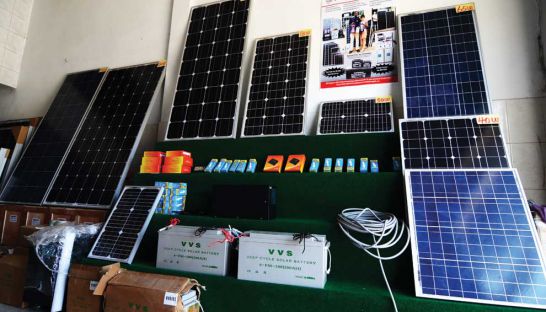Solar pegged for urban expansion
Solar pegged for urban expansion
Solar power has always been an easier sell in sun-drenched rural Cambodia, where millions of villagers live beyond the reach of electrical grids and those with connections face tariffs up to a staggering 3,000-riel per kilowatt hour.

Declining prices of solar technology and a growing array of instalment plans geared for low-income families have convinced an increasing number of villagers to harness the sun to power their homes.
But convincing Cambodia’s city-dwellers to invest in solar power is a much steeper challenge, though one that solar energy provider Kamworks Utility says it is now ready to tackle.
Ken Bradley, the company’s director of business development, said yesterday that after years of routine installations in rural areas, Kamworks is considering opportunities to deploy solar technologies in Phnom Penh’s urban jungle. He said the initial focus would likely be on new residential developments, such as apartment buildings and condominiums.
“In my view, the sweet spot is to integrate solar panels into new homes currently being developed,” he said. “The thing with solar is if you include it as part of the upfront costs of building a house, it does not seem so expensive.”
The Dutch-founded solar company has already tested the market, inking a deal with a local property management firm last October to install and maintain photovoltaic (PV) solar panels on the roof of Silvertown Metropolitan, a 110-unit serviced apartment tower in Boueng Keng Kang 1.
The solar panel array is said to generate enough electricity to cover about 12 percent of the building’s energy footprint, cutting its power costs.
Bradley said putting solar panels on residential projects, especially ones that have constant energy needs, made for a sound investment and significant energy cost reductions. The return on investment period was an impressive five to seven years, while the PV panels carry a 25- to 30-year warranty.
“It is definitely a market segment that keeps drawing interest,” he said. “I think that multi-unit buildings have a lot more appeal right now because there is a lot of distributed demand and it reduces their operating costs.”
Implementing a national net metering system that would see customers able to sell excess energy production to the grid would go a long way to promoting solar home systems, he added.
“In an ideal world we would have a net metering policy in place to pay customers for extra energy production,” he said.
Ngeth Chou, founding chairman of the Solar Energy Association of Cambodia, also emphasised the necessity of net metering to fully develop the potential of solar in Cambodia. Yet even without it, he saw opportunities in the urban residential market.
“The market has potential as [solar panels] would basically reduce electricity bills for homes,” he said. “In Phnom Penh, everyone has access to the grid, but solar could still become popular.” But for that to happen, the city’s residents would need to better understand the cost benefits of solar power, he said.
Khiev Thida, manager of local company Solar Green Energy, said that the vast majority of her installations were in the provinces where no grid connections are available. She said cost was the primary factor in people’s decision to choose solar.
“In Cambodia, people would turn to solar because they are thinking mainly about costs, whereas other countries people often focus more on environmental benefits,” she explained.
Thida added, however, that solar technology still had some hurdles to overcome, particularly that energy availability is at its lowest during peak usage periods.
“In homes right now it might not be very efficient because households use more electricity at night compared to daytime,” she said.
Bradley, however, said with advances in battery storage technology he expects solar to become an increasingly attractive option for individual homeowners.
“Eventually storage is going to make more and more sense, but we are at least three or four years away from that right now,” he said.













